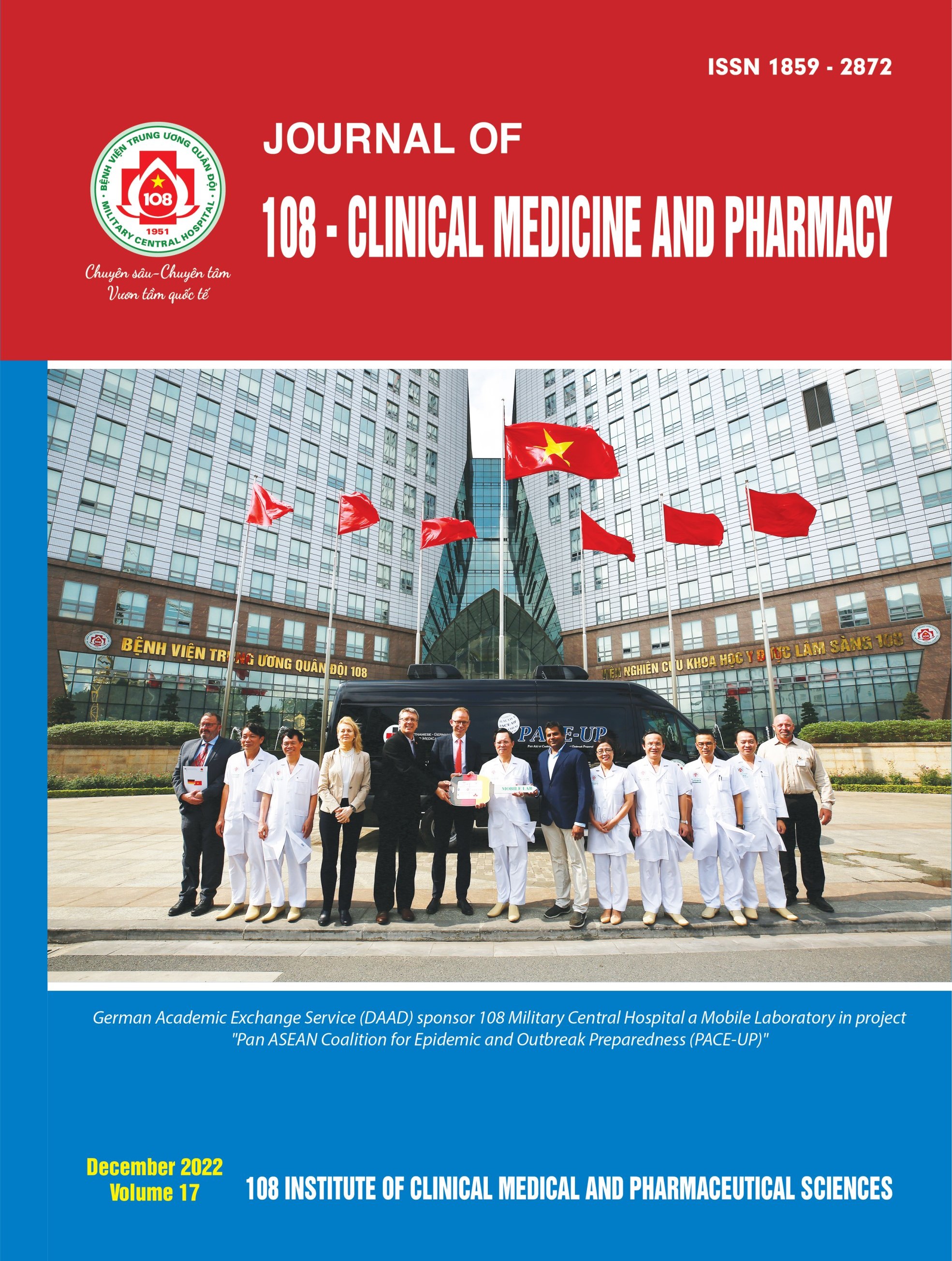Antibiotic susceptibility of Pseudomonas aeruginosa isolated at 108 Military Central Hospital from 01/2020 to 06/2022
Main Article Content
Keywords
Abstract
Objective: To determine antibiotic susceptibility patterns of Pseudomonas aeruginosa isolated at the 108 Military Central Hospital from January 2020 to June 2022. Subject and method: A total of 784 Pseudomonas aeruginosa strains were isolated from patient specimens from different departments. Bacteria identification and antibiotic susceptibility test were performed using the Vitek MS system and the Vitek-2 Compact system, respectively. Multidrug-resistant and/or carbapenem-resistant Pseudomonas aeruginosa (MDR/CPR P. aeruginosa) strains were determined. Colistin susceptibility test was done using cation-modified Muller-Hinton broth diffusion method (CBDE, colistin broth disk elution). Result: Pseudomonas aeruginosa was highly resisting to fluoroquinolones (62.8%), and aminoglycosides (53.4%). The proportion of MDR/CPR P. aeruginosa was 54.3% (426/784), of which the highest proportion was found in the Department of Infectious Diseases (65.52%), ICU (64.39%) and the Internal Respiratory Department (45.69%). Carbapenem-resistant Pseudomonas aeruginosa was highly prevalent in urine specimens (65.38%) and respiratory specimens (56.76%). Of 258 MDR/CPR P. aeruginosa isolates, 11.2% isolates were resistant to colistin, 26.6% and 33.3% of these remained susceptible to amikacin and piperacillin/tazobactam, respectively. Conclusion: The prevalence of antibiotic resistante Pseudomonas aeruginosa remains high, including resistance to carbapenem and colistin. Antibiotic regimen should include amikacin or piperacillin/tazobactam in combination with other antibiotics. The study suggested the routine application of diagnostic tools for the rapid detection of resistant strains.
Article Details
References
2. Phạm Thị Hoài An, Vũ Lê Ngọc Lan, Uông Nguyễn Đức Ninh, Phan Ngọc Thảo, Cao Hữu Nghĩa (2014) Khảo sát sự kháng kháng sinh của Klebsiella pneumoniae trên bệnh phẩm phân lập được tại Viện Pasteur, TP Hồ Chí Minh. Tạp chí KHOA HỌC ĐHSP TP. HCM, Số 61, tr. 146-155.
3. Kang CI, Kim SH, Kim HB, Park SW, Choe YJ, Oh MD, et al (2003) Pseudomonas aeruginosa bacteremia: risk factors for mortality and influence of delayed receipt of effective antimicrobial therapy on clinical outcome. Clin Infect Dis 37: 745-751.
4. CDC’s Antibiotic Resistance Threats in the United States, 2019.
5. Lin KY, Lauderdale TL, Wang JT, Chang SC (2016) Carbapenem-resistant Pseudomonas aeruginosa in Taiwan: Prevalence, risk factors, and impact on outcome of infections. Journal of Microbiology, Immunology and Infection 49(1): 52-59.
6. Le NK, Hf W, Vu PD, Khu DTK, Le HT, Hoang BTN, Vo VT, Lam YM, Vu DTV, Nguyen TH, Thai TQ, Nilsson LE, Rydell U, Nguyen KV, Nadjm B, Clarkson L, Hanberger H, Larsson M (2016) High prevalence of hospital-acquired infections caused by gram-negative carbapenem resistant strains in Vietnamese pediatric ICUs: A multi-centre point prevalence survey. Medicine (Baltimore) 95(27): e4099. doi: 10.1097/MD.0000000000004099.
7. Javed M, Ueltzhoeffer V, Heinrich M, Siegrist HJ, Wildermuth R, Lorenz FR, Neher RA, Willmann M (2018) Colistin susceptibility test evaluation of multiple-resistance-level Pseudomonas aeruginosa isolates generated in a morbidostat device. Ournal of Antimicrobial Chemotherapy 73(12): 3368-3374.
8. Nam NS and & Eight ND (2018) Analysis of carbapenem antibiotic consumption at the 108th Army Central Hospital from 2015 to 2017. Journal of 108 - Clinical Medicine and Phamarcy13(8): 78-84.
9. Trần Văn Ngọc, Phạm Thị Ngọc Thảo, Trần Thị Thanh Nga (2017) Khảo sát đặc điểm kháng thuốc của Pseudomonas aeruginosa và Acinetobacter baumannii gây viêm phổi bệnh viện. Thời sự Y học, tr. 64-69.
 ISSN: 1859 - 2872
ISSN: 1859 - 2872
